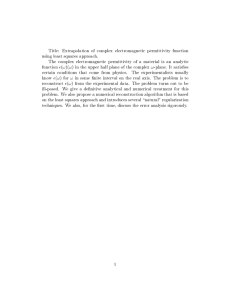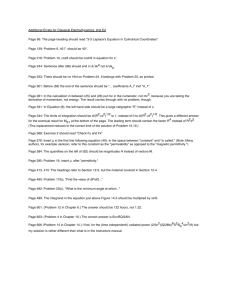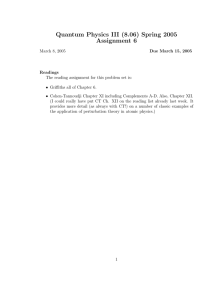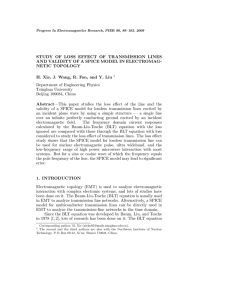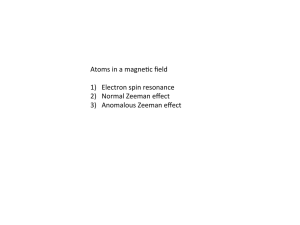MASSACHUSETTS INSTITUTE OF TECHNOLOGY Department of Electrical Engineering and Computer Science
advertisement
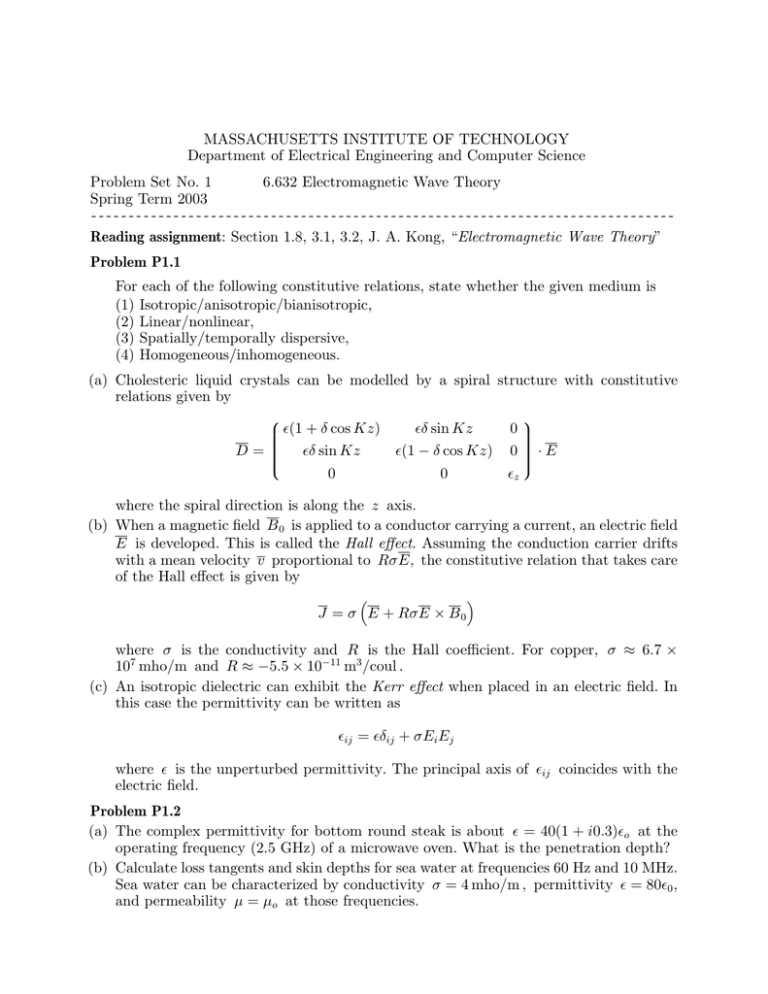
MASSACHUSETTS INSTITUTE OF TECHNOLOGY Department of Electrical Engineering and Computer Science Problem Set No. 1 6.632 Electromagnetic Wave Theory Spring Term 2003 -----------------------------------------------------------------------------Reading assignment: Section 1.8, 3.1, 3.2, J. A. Kong, “Electromagnetic Wave Theory” Problem P1.1 For each of the following constitutive relations, state whether the given medium is (1) Isotropic/anisotropic/bianisotropic, (2) Linear/nonlinear, (3) Spatially/temporally dispersive, (4) Homogeneous/inhomogeneous. (a) Cholesteric liquid crystals can be modelled by a spiral structure with constitutive relations given by (1 + δ cos Kz) D = δ sin Kz 0 δ sin Kz 0 (1 − δ cos Kz) 0 · E 0 z where the spiral direction is along the z axis. (b) When a magnetic field B 0 is applied to a conductor carrying a current, an electric field E is developed. This is called the Hall effect. Assuming the conduction carrier drifts with a mean velocity v proportional to RσE, the constitutive relation that takes care of the Hall effect is given by J = σ E + RσE × B 0 where σ is the conductivity and R is the Hall coefficient. For copper, σ ≈ 6.7 × 107 mho/m and R ≈ −5.5 × 10−11 m3 /coul . (c) An isotropic dielectric can exhibit the Kerr effect when placed in an electric field. In this case the permittivity can be written as ij = δij + σEi Ej where is the unperturbed permittivity. The principal axis of ij coincides with the electric field. Problem P1.2 (a) The complex permittivity for bottom round steak is about = 40(1 + i0.3)o at the operating frequency (2.5 GHz) of a microwave oven. What is the penetration depth? (b) Calculate loss tangents and skin depths for sea water at frequencies 60 Hz and 10 MHz. Sea water can be characterized by conductivity σ = 4 mho/m , permittivity = 800 , and permeability µ = µo at those frequencies. (c) A 100-Hz electromagnetic wave is propagating down into the sea water with an electric field intensity E of 1 V/m just beneath the sea surface. What is the intensity of E at a depth of 100 m? What are the time-average Poynting’s power densities just beneath the surface and at a depth of 100 m? Problem P1.3 (a) An ionized plasma is dispersive; derive its group velocity vg if µ = µ0 and = 0 (1 − ωp2 /ω 2 ) , where ωp = Ne2 /mo , N is the number of free electrons per cubic meter, e is the charge of an electron (coulombs), and m is the mass of an electron (kg). (b) What is the difference in arrival times between a flash of light (λ = 0.5µm) and a simultaneous radio pulse (f = 10 MHz) seen through an idealized homogeneous ionosphere where ωp = 2π × 8 MHz along a path of 100 km? Problem P1.4 To shield a room from radio interference, the room must be enclosed in a layer of copper five skin-depths thick. If the frequency to be shielded against in 10 kHz to 1 GHz, what should be the thickness of the copper (in millimeters)? For copper, = 0 , µ = µ0 and σ = 5.8 × 107 mho/m.
